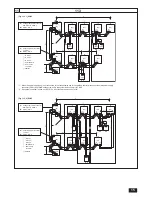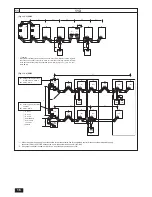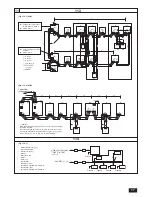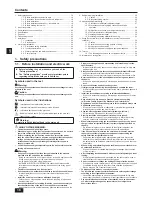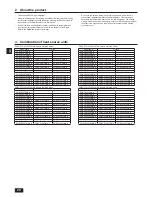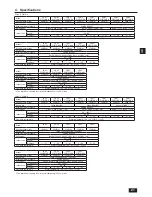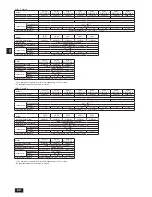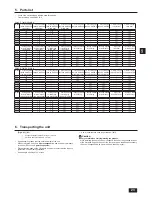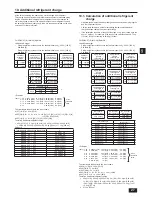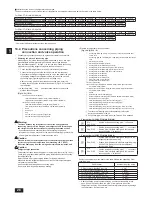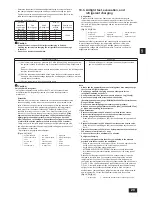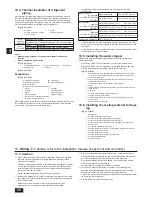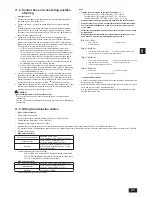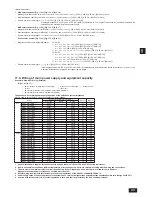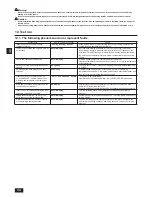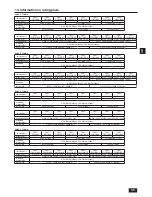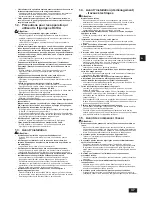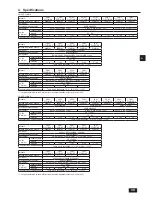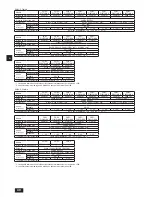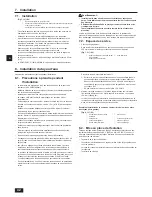
29
GB
Determine the amount of additional refrigerant charge by using the formula,
and charge refrigerant through the service port after connecting the pipes.
Tighten the service port and cap securely so gas does not leak. (Refer to the
WDEOHEHORZIRUDSSURSULDWHWLJKWHQLQJWRUTXH
Appropriate tightening torque:
Outside
diameter of
copper pipe
PP>LQ@
Cap
1āPNJāFP
Shaft
1āPNJāFP
Size of
hexagonal
wrench
PP
Service port
1āPNJāFP
ø9.52 [3/8]
15/150
6/60
4
12/120
ø12.7 [1/2]
20/200
9/90
4
ø15.88 [5/8]
25/250
15/150
6
ø19.05 [3/4]
25/250
30/300
8
ø25.4 [1]
25/250
30/300
8
Caution:
.HHSWKHYDOYHFORVHGXQWLOWKHUHIULJHUDQWFKDUJLQJLV¿QLVKHG
Opening the valve before charging the refrigerant may cause damage
to the unit.
Do not use a leak detection additive.
10.3. Airtight test, evacuation, and
refrigerant charging
1
Airtight test
Perform with the valve of the heat source unit closed, charging the
refrigerant pressurize the connection piping and the indoor unit from the
service port provided on the valve of the heat source unit. (Always pressurize
from both the high-pressure/gas pipe and the low-pressure/liquid pipe
VHUYLFHSRUWV
[Fig. 10.3.1] (P.12)
A
Nitrogen gas
B
To indoor unit
C
System analyzer
D
Low knob
E
High knob
F
Valve
G
Low-pressure/liquid pipe
H
High-pressure/gas pipe
I
Heat source unit
J
Service port
Observe the following restrictions when conducting the air tightness test
to prevent negative effects on the refrigerating machine oil. Also, with
QRQD]HRWURSLFUHIULJHUDQW5$JDVOHDNDJHFDXVHVWKHUHIULJHUDQW
composition to change and affects performance. Therefore, conduct the
airtightness test cautiously.
Caution:
Only use R410A refrigerant.
- Using other refrigerants such as R22 or R407C, which contains chlorine,
will deteriorate the refrigerating machine oil or cause the compressor to
malfunction.
2
Evacuation
Evacuate with the valve of the heat source unit closed and evacuate both the
connection piping and the indoor unit from the service port provided on the
valve of the heat source unit using a vacuum pump. (Always evacuate from
the service port of both the high-pressure/gas pipe and the low-pressure/
OLTXLGSLSH$IWHUWKHYDFXXPUHDFKHV3D>DEV@
[0.0943psi/5Torr],
evacuate for at least one hour or more. Then, stop the vacuum pump and
leave it for 1 hour. Ensure the degree of vacuum has not increased.
(If the
degree of vacuum increase is larger than 130 Pa [0.01886psi/1.0Torr],
water might present. Apply pressure to dry nitrogen gas up to 0.05
MPa [7.25psi] and vacuum again. Repeat the evacuation process three
or more times until the vacuum pressure is lost by 130 Pa or below.)
Finally, seal in with the liquid refrigerant through the high-pressure/gas pipe,
DQGDGMXVWWKHORZSUHVVXUHOLTXLGSLSLQJWRREWDLQDQDSSURSULDWHDPRXQWRI
the refrigerant for operation.
* Never perform air purging with refrigerant.
[Fig. 10.3.2] (P.12)
A
System analyzer
B
Low knob
C
High knob
D
Valve (heat source
XQLW
E
Low-pressure/liquid
pipe
F
High-pressure/gas
pipe
G
Service port
H
7KUHHZD\MRLQW
I
Valve
J
Valve
K
R410A cylinder
L
Scale
M
Vacuum pump
N
To indoor unit
O
Heat source unit
Note:
Always add the appropriate amount of refrigerant. Also always charge
the system with liquid refrigerant.
Use a gauge manifold, charging hose, and other parts for the
refrigerant indicated on the unit.
Use a graviometer. (One that can measure down to 0.1 kg [302oz].)
8VHDYDFXXPSXPSZLWKDUHYHUVHÀRZFKHFNYDOYH
(Recommended vacuum gauge: ROBINAIR 14830A Thermistor Vacuum
Gauge or Micron Gauge)
Do not use a manifold gauge to measure vacuum pressure.
Also use a vacuum gauge that reaches 65 Pa [abs] [0.00943psi/0.5Torr]
RUEHORZDIWHURSHUDWLQJIRU¿YHPLQXWHV
<Triple Evacuation>
Evacuate the system to 4,000 microns from both service valves.
System manifold gauges must not be used to measure vacuum.
A micron gauge must be used at all times.
%UHDNWKHYDFXXPZLWK1LWURJHQ1LQWRWKHGLVFKDUJHVHUYLFHYDOYHWR
PSIG.
Evacuate the system to 1,500 microns from the suction service valve.
%UHDNWKHYDFXXPZLWK1LWURJHQ1LQWRWKHGLVFKDUJHVHUYLFHYDOYHWR
PSIG.
Evacuate the system to 500 microns. System must hold the vacuum at
500 microns for a minimum of 1 hour.
Conduct a rise test for a minimum of 30 minutes.
3
Refrigerant Charging
Do not use refrigerant other than the type indicated in the manuals
provided with the unit and on the nameplate.
'RLQJVRPD\FDXVHWKHXQLWRUSLSHVWREXUVWRUUHVXOWLQH[SORVLRQRU¿UH
during use, during repair, or at the time of disposal of the unit.
- It may also be in violation of applicable laws.
- MITSUBISHI ELECTRIC CORPORATION cannot be held responsible
for malfunctions or accidents resulting from the use of the wrong type of
refrigerant.
Because the refrigerant used with the unit is nonazerotropic, it must be
charged in the liquid state. Consequently, when charging the unit with
refrigerant from a cylinder, if the cylinder does not have a siphon pipe,
charge the liquid refrigerant by turning the cylinder upside-down as shown in
Fig.10.3.3. If the cylinder has a siphon pipe like that shown in the picture on
Fig.10.3.3, the liquid refrigerant can be charged with the cylinder standing
XSULJKW)ROORZWKHF\OLQGHUVSHFL¿FDWLRQVFDUHIXOO\,IWKHXQLWVKRXOG
accidentally be charged with gas refrigerant, replace all the refrigerant with
new refrigerant. Do not use the refrigerant remaining in the cylinder.
[Fig. 10.3.3] (P.12)
A
Siphon pipe
B
If the R410A cylinder does not have a siphon pipe.
Airtight test procedure
Restriction
$IWHUREWDLQLQJWRWKHGHVLJQSUHVVXUH03D
[602psi]
XVLQJQLWURJHQJDVDOORZ
the system to stand for about one day. If the pressure does not drop, airtightness is
good.
However, if the pressure drops, and the leakage area is unknown, the following bubble
test may also be performed.
$IWHUWKHSUHVVXUL]DWLRQGHVFULEHGDERYHVSUD\WKHÀDUHFRQQHFWLRQSDUWVEUD]HG
SDUWVDQGRWKHUSRWHQWLDOOHDNDJHDUHDVZLWKDEXEEOLQJDJHQW.\XERÀH[HWFDQG
visually check for bubbles.
$IWHUWKHDLUWLJKWWHVWZLSHRIIWKHEXEEOLQJDJHQW
,IDÀDPPDEOHJDVRUDLUR[\JHQLVXVHGDVWKHSUHVVXUL]DWLRQ
JDVLWPD\FDWFK¿UHRUH[SORGH
Содержание CITY MULTI PQHY-P-TLMU-A
Страница 55: ......

